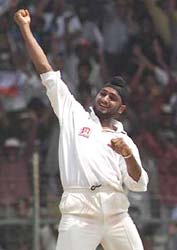 Home > Cricket > Diary archives
Home > Cricket > Diary archivesAugust 11, 2002
The art of field messing
Prem Panicker
 Shortly before the start of the second Test, Rediff had carried a special feature on Harbhajan Singh.
That feature was intended to make two points: One, that merely replacing Anil Kumble for the off-spinner was not going to get us wickets and a possible win; and two, that the off spinner's effectiveness would depend, entirely, on the field that was placed for him.
Shortly before the start of the second Test, Rediff had carried a special feature on Harbhajan Singh.
That feature was intended to make two points: One, that merely replacing Anil Kumble for the off-spinner was not going to get us wickets and a possible win; and two, that the off spinner's effectiveness would depend, entirely, on the field that was placed for him.
Check the recommended field out
The underlying theory is simple: against such types of bowling, the batsman is looking to try and relieve pressure by working him around, taking singles and the occasional twos, rotating strike so the spinner can't do what he likes doing best - namely, work on a batsman with variations of flight and loop and length and turn, and winkle him out.
The suggested field, thus, blocks various options for batsmen:
1) He cannot open the bat face and run the ball down into the backward point-third man arc.
2) He cannot go back, let the ball come in to him, then work it off his pads into the square leg-fine leg arc.
3) He cannot push the short single into the covers.
4) He cannot push the ball in front into the midwicket region and take the quick single.
Cumulatively, by blocking these three easy scoring opportunities, you force the batsman to play the off-spinner in the V - thus permitting the offie to apply pressure, force the mishit, bring the batsman down the track in an attempt to beat the field and get him stumped (think Ricky Ponting during Australia's last tour of India) et cetera.
As it turns out, Harbhajan bowled 45 of the 144.5 overs that the England innings lasted. Gave away 175 of the 617 runs England scored. And took 3 of the ten wickets to fall.
Very poor returns, by any yardstick.
Now check out a few figures, against the suggested field:
61 singles were taken off the off-spinner, in the innings. Of these, the vast majority - as many as 51 -- was scored through the square leg-fine leg arc.
In addition, 12 twos were scored in the same region. Which makes for a total of 75 runs coming off singles and twos as the batsmen played with the turn, late, off the pads - a little over one third of all the runs scored off the bowler.
Was there a square leg in place? A leg slip?
Reacting to the suggested field placing, several readers had pointed out that batsmen would try to sweep hard, looking for the fours. The point is, that is precisely what the off-spinner wants him to do - not take easy singles, but try for the big shots, because that is his best chance of getting the wicket. And as it turns out, that is precisely how Nasser Hussain gets out - attempting the sweep to Harbhajan, and gloving it to the keeper.
In passing, only 3 of the 16 fours scored off Harbhajan were through the sweep.
Here are a few more statistics:
Of the remaining 13 singles, four were scored through midwicket, five through cover. There were just two singles to mid on, just one solitary single to mid off. In other words, the batsmen were never forced to play the off-spinner in the V - why would they, when there was easy pickings to be had off the pads?

Interestingly, 22 twos were taken off the off-spinner. Again, the overwhelming number of twos came through fine leg - 9 of them, indicating firstly that the fielder was too far back and secondly, that India was `hiding' one of its slower outfielders in that region. Placing a leg slip would have blocked the attempt to play the ball in that region. And equally significantly, the second largest number of twos (four of them, PLUS a three) is scored to, of all places, third man - in other words, the batsman has no qualms about opening the bat face and running the ball down there. Why would he, when he does not have a slip to inhibit him, and third man is placed right on the line?
Forcing the batsman to play the off-spinner with the straight bat brings up various wicket-taking opportunities: the stumping, for starters; the leading edge; the outer edge as the batsman plays for the turn and the ball goes through straight; the mistimed push back to the bowler as the ball is held back a fraction as part of the off spinner's variations.
Throughout their innings, the England batsmen were never, ever, at risk of any of these dismissals.
EAS Prasanna, arguably our greatest off-spinner, once made the point in course of a casual chat that if off-spin bowling was an art, then setting a field for an off-spinner was equally an art. `Pras' suggested on that occasion that if it were not for the field-setting skills of the likes of Mansur Ali Khan Pataudi and Ajit Wadekar, and the close catching skills of the Solkars, Abid Alis, Venkatraghavans et al, he would not have been half as successful as he proved to be.
The art of field setting, it would appear, has in recent times been forgotten. And simultaneously, giving free runs to opposing batsmen has been made into a fine art.
Consider this: The England total 146 singles, and 46 twos. Of these, 33 singles and 10 twos are scored in the fine leg region; 41 singles and 9 twos to square leg. Talk of luxury - opposing batsmen, obviously, have been allowed to play the ball as late as they possibly can, thus reducing the risk to themselves while still keeping the board ticking over.
In one-day cricket, strategy is relatively simple - my batsman can hit longer, harder and more often than yours.
In Tests, much of the game is won or lost in the field. India - for 16 years now - has been losing, except on designer tracks at home.
Think why.
Postscript: This is not to suggest that there is only the one reason for our continued defeats; merely to point to a very important, and often ignored, cause.
The Rediff Diary -- the complete archives
![]()
![]()
Email : Prem Panicker
©1996 to 2001 rediff.com India Limited. All Rights Reserved.